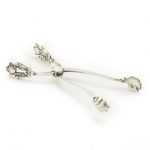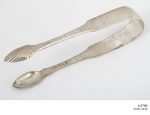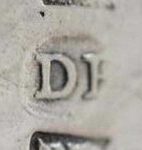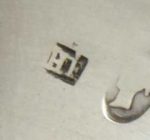Sugar tongs were designed to pick up cubes of sugar and date back to the mid eighteenth century. They are sometimes referred to as sugar nips, however, sugar nips were originally used to break off pieces of sugar from sugar-loaf.
FORRES: A rare pair of Scottish provincial silver sugar tongs by J & P Riach, marked on each arm with ‘IPR’ and tower mark Fiddle pattern with round bowls, length 15cm, weight 1.5oz.
Sold for £ 1,500 inc. premium at Bonhams in 2018
A PAIR OF SILVER SUGAR TONGS MARK OF JACOB HURD, BOSTON, 1735-45 Of typical scissor form, with shaped handles and arms, with rounded tips, engraved with initial R, marked on one arm with Kane mark D 4 ½ in. (11.3 cm.) long; 1 oz. (40 gr.)
Sold for USD 1,625 at Christies in 2015
Georg Jensen Sterling Silver Sugar Tongs In the Acorn pattern. Approximately 2 ounces.
Sold for $250 (includes buyer’s premium) at Doyle New York in 2013
RUSSIAN ENAMEL SILVER SUGAR TONGS Marked 84. Maker’s initials in Crylic.
Sold for $250 at Louvre Antique Auction in 2019
Sugar Tongs Maker: Joseph D. Chase (active ca. 1820–39) ca. 1820. Made in New York, New York, United States
Reference: The Metropolitan Museum of Art
Sugar tongs by Alexander Dick Made by Dick, Alexander in Sydney, New South Wales, Australia, 1834. Sugar tongs, made of silver with a decorative scallop shell design, made from a single strip of silver bent in half, the handle is a flat strip. Makers’s mark on inside arm.
Reference: Museum of Applied Art and Sciences
Sugar tongs about 1800 Samuel Drowne (1749–1815) Made in Portsmouth, New Hampshire, United States
The tongs are of bow form, with cast reticulated arms embellished with a double row of serpentine piercing, shell-shaped hollow grips, and a chased border on the shoulders and bow. In the federal period, the luxury craft of silversmithing spread from the established colonial urban centers of Boston, New York, and Philadelphia to growing cities such as Portsmouth, New Hampshire, where these high-quality sugar tongs were made.
Reference: Museum of Fine Arts Boston
A pair of George V novelty silver-gilt and enamel ‘Dutch Doll’ sugar tongs, Cohen & Charles, London, 1911 painted enamel head and hinged limbs, Cohen & Charles, London, 1911, in original case stamped by retailer ‘J.C. Vickery / 179 / 181 & 183 / Regent St. W.’ 12.1cm., 4 3/4 in. high 81.5gr., 2oz. 12dwt.
A very amusing is a pair of sugar-tongs, “the Dutch Doll” with the head in enamel and legs in silver or gilt.’ (From a review of J.C. Vickery’s Christmas stock, The lllustrated London News, London, Saturday, 30 November 1912, p. 808). The design of Dutch Doll pattern sugar tongs was inspired by the illustrations in The Adlentures of Two Dutch Dolls and a Golliwogg by Florence Kate Upton (1873-1922), published in 1895. These characters became so popular that they were adapted for the theatre; in 1901 a children’s play, Katawampus, included a live Dutch Doll and in 1905 a ballet at the Empire Theatre, Leicester Square, featured a similar Dutch Doll dance.
Sold for 1,875 GBP at Sothebys in 2019
Sugar Tongs by Thomas Tookey ca. 1770
Reference: © Victoria and Albert Museum










